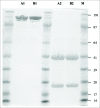IgG2m4, an engineered antibody isotype with reduced Fc function
- PMID: 20073128
- PMCID: PMC2791314
- DOI: 10.4161/mabs.1.6.10185
IgG2m4, an engineered antibody isotype with reduced Fc function
Abstract
The Fc region of an antibody mediates effector functions such as antibody-dependent cell-mediated cytotoxicity (ADCC) and complement-dependent cytotoxicity (CDC), and plays a key role in the in vivo half-life of an antibody. In designing antibody therapeutics, it is sometimes desirable that the antibody has altered Fc-mediated properties. In the case of a "benign blocker" antibody, it is often desirable to diminish or abolish the ADCC and CDC functions while retaining its PK profile. Here, we report a novel engineered IgG isotype, IgG2m4, with reduced Fc functionality. IgG2m4 is based on the IgG2 isotype with four key amino acid residue changes derived from IgG4 (H268Q, V309L, A330S and P331S). An IgG2m4 antibody has an overall reduction in complement and Fc gamma receptor binding in in vitro binding analyses while maintaining the normal in vivo serum half-life in rhesus.
Figures





References
-
- Maggon K. Monoclonal antibody “Gold Rush”. Current Medicinal Chemistry. 2007;14:1978–1987. - PubMed
-
- Goldsby RA, Kindt TJ, Osborne BA, Kuby J. Immunology. 5th Edition. New York: W.H. Freeman and Company; 2003.
-
- Dall'Acqua WF, Kiener PA, Wu H. Properties of human IgG1s engineered for enhanced binding to the neonatal Fc receptor (FcRn) J Biol Chem. 2006;281:23514–23524. - PubMed
-
- Firan M, Bawdon R, Radu C, Ober RJ, Eaken D, Antohe F, et al. The MHC class I-related receptor, FcRn, plays an essential role in the maternofetal transfer of gamma-globulin in humans. Int Immunol. 2001;13:993–1002. - PubMed
-
- Roopenian DC, Akilesh S. FcRn: the neonatal Fc receptor comes of age. Nature Review Immunol. 2007;7:715–725. - PubMed
MeSH terms
Substances
LinkOut - more resources
Full Text Sources
Other Literature Sources
